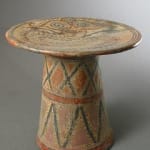Cocle Terracotta Pedestal Bowl, 800 CE - 1200 CE
Terracotta
21
PF.3533
Further images
Archaeological excavations in the Cocle Province located in Central Panama have revealed that an ancient civilization once inhabited these lands. The findings suggested that the so-called Cocle culture arose around...
Archaeological excavations in the Cocle Province located in Central Panama have revealed that an ancient civilization once inhabited these lands. The findings suggested that the so-called Cocle culture arose around 500 A.D. and lasted until about 1000 A.D. Although their dating is roughly contemporaneous with the Diquis culture to the north in modern day Costa Rica, the art they left behind suggests that they were a unique, independent civilization. Cocle art, which consists primarily of unslipped or buff slipped pottery and terracotta sculptures, is distinguished by their polychrome hues and lively asymmetrical motifs which often include animal themes.
Sculpted in Ancient Central America, this white-slipped terracotta pedestal is elegantly decorated, with the top slate depicting an Ancient Costa Rican mythical creature. The fluid orange lines portray the form and the swift movement of the creature, and short black lines indicating the eyes, arms, and scale-like forms of the body. Its dramatic expression is surely to grab anyone's attention and it is interesting to wonder what kind of mythical world from which this creature originated. The support of the pedestal is enhanced with colorful, geometric patterns. It is divided into two bands--the top is decorated with large, black x shapes and the bottom with black v shapes. Most likely used in rituals and ceremonies, this pedestal most likely had a specific meaning and significance. Perhaps it supported a ritual offering which was to please the gods. As we contemplate this wonderful sculpture, we deeply appreciate its fascinating cultural history and its breath-taking artistic quality.
Sculpted in Ancient Central America, this white-slipped terracotta pedestal is elegantly decorated, with the top slate depicting an Ancient Costa Rican mythical creature. The fluid orange lines portray the form and the swift movement of the creature, and short black lines indicating the eyes, arms, and scale-like forms of the body. Its dramatic expression is surely to grab anyone's attention and it is interesting to wonder what kind of mythical world from which this creature originated. The support of the pedestal is enhanced with colorful, geometric patterns. It is divided into two bands--the top is decorated with large, black x shapes and the bottom with black v shapes. Most likely used in rituals and ceremonies, this pedestal most likely had a specific meaning and significance. Perhaps it supported a ritual offering which was to please the gods. As we contemplate this wonderful sculpture, we deeply appreciate its fascinating cultural history and its breath-taking artistic quality.





